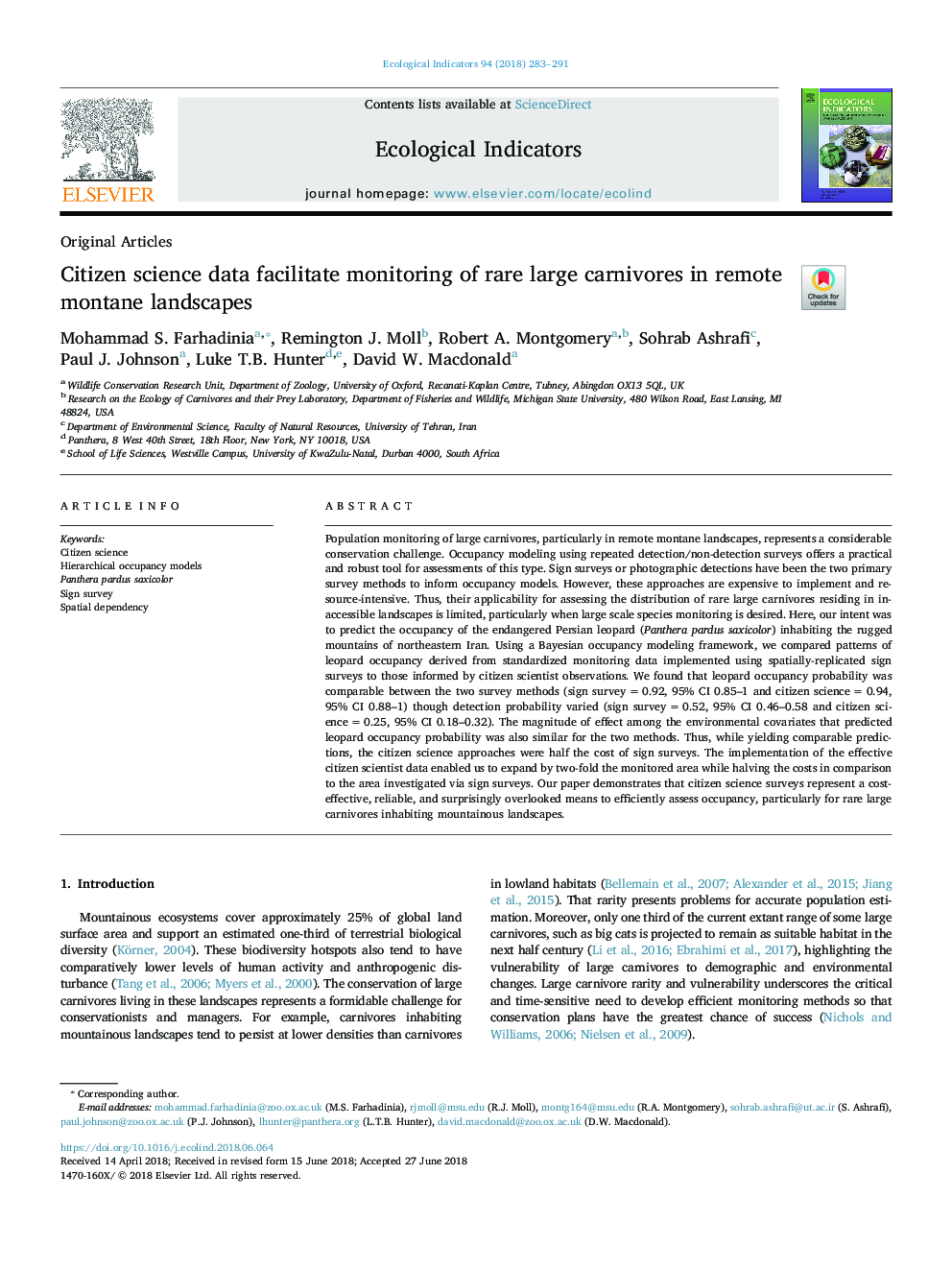| کد مقاله | کد نشریه | سال انتشار | مقاله انگلیسی | نسخه تمام متن |
|---|---|---|---|---|
| 8845070 | 1617108 | 2018 | 9 صفحه PDF | دانلود رایگان |
عنوان انگلیسی مقاله ISI
Citizen science data facilitate monitoring of rare large carnivores in remote montane landscapes
ترجمه فارسی عنوان
داده های علمی شهروندان نظارت بر ناهارخوری های نادر بزرگ در منظره های مونتان دور را تسهیل می کند
دانلود مقاله + سفارش ترجمه
دانلود مقاله ISI انگلیسی
رایگان برای ایرانیان
موضوعات مرتبط
علوم زیستی و بیوفناوری
علوم کشاورزی و بیولوژیک
بوم شناسی، تکامل، رفتار و سامانه شناسی
چکیده انگلیسی
Population monitoring of large carnivores, particularly in remote montane landscapes, represents a considerable conservation challenge. Occupancy modeling using repeated detection/non-detection surveys offers a practical and robust tool for assessments of this type. Sign surveys or photographic detections have been the two primary survey methods to inform occupancy models. However, these approaches are expensive to implement and resource-intensive. Thus, their applicability for assessing the distribution of rare large carnivores residing in inaccessible landscapes is limited, particularly when large scale species monitoring is desired. Here, our intent was to predict the occupancy of the endangered Persian leopard (Panthera pardus saxicolor) inhabiting the rugged mountains of northeastern Iran. Using a Bayesian occupancy modeling framework, we compared patterns of leopard occupancy derived from standardized monitoring data implemented using spatially-replicated sign surveys to those informed by citizen scientist observations. We found that leopard occupancy probability was comparable between the two survey methods (sign surveyâ¯=â¯0.92, 95% CI 0.85-1 and citizen scienceâ¯=â¯0.94, 95% CI 0.88-1) though detection probability varied (sign surveyâ¯=â¯0.52, 95% CI 0.46-0.58 and citizen scienceâ¯=â¯0.25, 95% CI 0.18-0.32). The magnitude of effect among the environmental covariates that predicted leopard occupancy probability was also similar for the two methods. Thus, while yielding comparable predictions, the citizen science approaches were half the cost of sign surveys. The implementation of the effective citizen scientist data enabled us to expand by two-fold the monitored area while halving the costs in comparison to the area investigated via sign surveys. Our paper demonstrates that citizen science surveys represent a cost-effective, reliable, and surprisingly overlooked means to efficiently assess occupancy, particularly for rare large carnivores inhabiting mountainous landscapes.
ناشر
Database: Elsevier - ScienceDirect (ساینس دایرکت)
Journal: Ecological Indicators - Volume 94, Part 1, November 2018, Pages 283-291
Journal: Ecological Indicators - Volume 94, Part 1, November 2018, Pages 283-291
نویسندگان
Mohammad S. Farhadinia, Remington J. Moll, Robert A. Montgomery, Sohrab Ashrafi, Paul J. Johnson, Luke T.B. Hunter, David W. Macdonald,
